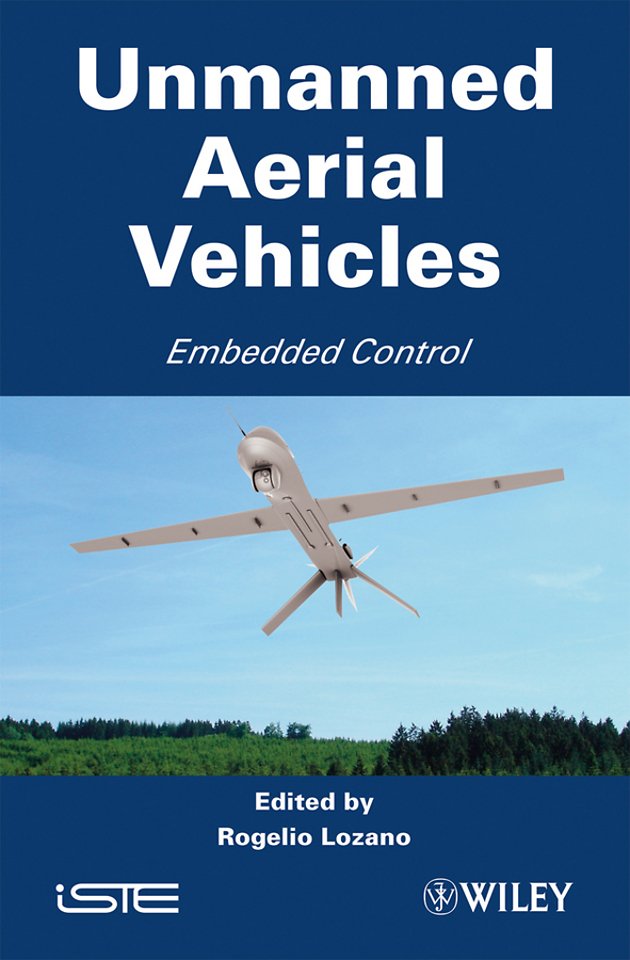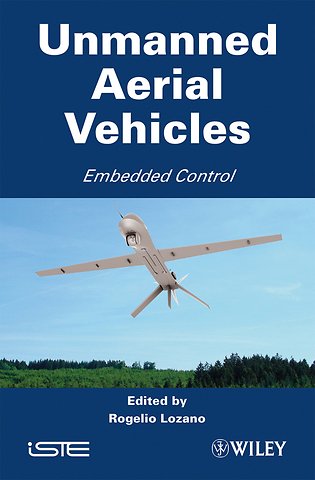Unmanned Aerial Vehicles Embedded Control
Embedded Control
Gebonden Engels 2010 9781848211278Samenvatting
This book presents the basic tools required to obtain the dynamical models for aerial vehicles (in the Newtonian or Lagrangian approach). Several control laws are presented for mini–helicopters, quadrotors, mini–blimps, flapping–wing aerial vehicles, planes, etc. Finally, this book has two chapters devoted to embedded control systems and Kalman filters applied for aerial vehicles control and navigation. This book presents the state of the art in the area of UAVs. The aerodynamical models of different configurations are presented in detail as well as the control strategies which are validated in experimental platforms.
Specificaties
Lezersrecensies
Inhoudsopgave
<p>1.1. Aerodynamic configurations 1</p>
<p>1.2. Dynamic models 6</p>
<p>1.2.1. Newton–Euler approach 7</p>
<p>1.2.2. Euler–Lagrange approach 9</p>
<p>1.2.3. Quaternion approach 10</p>
<p>1.2.4. Example: dynamic model of a quad–rotor rotorcraft 13</p>
<p>1.3. Bibliography 20</p>
<p>Chapter 2. Nested Saturation Control for Stabilizing the PVTOL Aircraft 21<br /> Isabelle FANTONI and Amparo PALOMINO</p>
<p>2.1. Introduction 21</p>
<p>2.2. Bibliographical study 22</p>
<p>2.3. The PVTOL aircraft model 24</p>
<p>2.4. Control strategy 25</p>
<p>2.4.1. Control of the vertical displacement y 26</p>
<p>2.4.2. Control of the roll angle and the horizontal displacement x 27</p>
<p>2.5. Other control strategies for the stabilization of the PVTOL aircraft 33</p>
<p>2.6. Experimental results 33</p>
<p>2.7. Conclusions 38</p>
<p>2.8. Bibliography 38</p>
<p>Chapter 3. Two–Rotor VTOLMini UAV: Design, Modeling and Control 41<br /> Juan ESCARENO, Sergio SALAZAR and Eduardo RONDON</p>
<p>3.1. Introduction 41</p>
<p>3.2. Dynamic model 43</p>
<p>3.2.1. Kinematics 44</p>
<p>3.2.2. Dynamics 44</p>
<p>3.2.3. Model for control analysis 48</p>
<p>3.3. Control strategy 48</p>
<p>3.3.1. Altitude control 49</p>
<p>3.3.2. Horizontal motion control 49</p>
<p>3.3.3. Attitude control 50</p>
<p>3.4. Experimental setup 51</p>
<p>3.4.1. Onboard flight system (OFS) 52</p>
<p>3.4.2. Outboard visual system 53</p>
<p>3.4.3. Experimental results 55</p>
<p>3.5. Concluding remarks 56</p>
<p>3.6. Bibliography 56</p>
<p>Chapter 4. Autonomous Hovering of a Two–Rotor UAV 59<br /> Anand SANCHEZ, Juan ESCARENO and Octavio GARCIA</p>
<p>4.1. Introduction 59</p>
<p>4.2. Two–rotor UAV 60</p>
<p>4.2.1. Description 61</p>
<p>4.2.2. Dynamic model 61</p>
<p>4.3. Control algorithm design 67</p>
<p>4.4. Experimental platform 73</p>
<p>4.4.1. Real–time PC–control system (PCCS) 73</p>
<p>4.4.2. Experimental results 74</p>
<p>4.5. Conclusion 76</p>
<p>4.6. Bibliography 77</p>
<p>Chapter 5. Modeling and Control of a Convertible Plane UAV 79<br /> Octavio GARCIA, Juan ESCARENO and Victor ROSAS</p>
<p>5.1. Introduction 79</p>
<p>5.2. Convertible plane UAV80</p>
<p>5.2.1. Vertical mode 80</p>
<p>5.2.2. Transition maneuver 81</p>
<p>5.2.3. Horizontal mode 81</p>
<p>5.3. Mathematical model 81</p>
<p>5.3.1. Translation of the vehicle 82</p>
<p>5.3.2. Orientation of the vehicle 83</p>
<p>5.3.3. Equations of motion 85</p>
<p>5.4. Controller design 86</p>
<p>5.4.1. Hover control 86</p>
<p>5.4.2. Transition maneuver control 96</p>
<p>5.4.3. Horizontal flight control 102</p>
<p>5.5. Embedded system 106</p>
<p>5.5.1. Experimental platform 106</p>
<p>5.5.2. Microcontroller 108</p>
<p>5.5.3. Inertial measurement unit (IMU) 109</p>
<p>5.5.4. Sensor fusion 109</p>
<p>5.6. Conclusions and future works 111</p>
<p>5.6.1. Conclusions 111</p>
<p>5.6.2. Future works 112</p>
<p>5.7. Bibliography 112</p>
<p>Chapter 6. Control of Different UAVs with Tilting Rotors 115<br /> Juan ESCARENO, Anand SANCHEZ and Octavio GARCIA</p>
<p>6.1. Introduction 115</p>
<p>6.2. Dynamic model of a flying VTOL vehicle 116</p>
<p>6.2.1. Kinematics 117</p>
<p>6.2.2. Dynamics 118</p>
<p>6.3. Attitude control of a flying VTOL vehicle 119</p>
<p>6.4. Triple tilting rotor rotorcraft: Delta 119</p>
<p>6.4.1. Kinetics of Delta 120</p>
<p>6.4.2. Torques acting on the Delta 121</p>
<p>6.4.3. Experimental setup 123</p>
<p>6.4.4. Experimental results 125</p>
<p>6.5. Single tilting rotor rotorcraft: T–Plane 127</p>
<p>6.5.1. Forces and torques acting on the vehicle 127</p>
<p>6.5.2. Experimental results 129</p>
<p>6.6. Concluding remarks 131</p>
<p>6.7. Bibliography 132</p>
<p>Chapter 7. Improving Attitude Stabilization of a Quad–Rotor UsingMotor Current Feedback 133<br /> Anand SANCHEZ, Luis GARCIA–CARRILLO, Eduardo RONDON and Octavio GARCIA</p>
<p>7.1. Introduction 133</p>
<p>7.2. Brushless DC motor and speed controller 134</p>
<p>7.3. Quad–rotor 138</p>
<p>7.3.1. Dynamic model 139</p>
<p>7.4. Control strategy 140</p>
<p>7.4.1. Attitude control 140</p>
<p>7.4.2. Armature current control 142</p>
<p>7.5. System configuration 144</p>
<p>7.5.1. Aerial vehicle 145</p>
<p>7.5.2. Ground station 146</p>
<p>7.5.3. Vision system 147</p>
<p>7.6. Experimental results 148</p>
<p>7.7. Concluding remarks 150</p>
<p>7.8. Bibliography 151</p>
<p>Chapter 8. Robust Control Design Techniques Applied toMini–Rotorcraft UAV: Simulation and Experimental Results 153<br /> José Alfredo GUERRERO, Gerardo ROMERO, Rogelio LOZANO and Efraín ALCORTA</p>
<p>8.1. Introduction 153</p>
<p>8.2. Dynamic model 155</p>
<p>8.3. Problem statement 156</p>
<p>8.4. Robust control design 158</p>
<p>8.5. Simulation and experimental results 160</p>
<p>8.5.1. Simulations 160</p>
<p>8.5.2. Experimental platform 162</p>
<p>8.6. Conclusions 164</p>
<p>8.7. Bibliography 164</p>
<p>Chapter 9. Hover Stabilization of a Quad–Rotor Using a Single Camera 167<br /> Hugo ROMERO and Sergio SALAZAR</p>
<p>9.1. Introduction 167</p>
<p>9.2. Visual servoing 168</p>
<p>9.2.1. Direct visual servoing 169</p>
<p>9.2.2. Indirect visual servoing 169</p>
<p>9.2.3. Position based visual servoing 170</p>
<p>9.2.4. Image–based visual servoing 171</p>
<p>9.2.5.Position–image visual servoing 172</p>
<p>9.3. Camera calibration 173</p>
<p>9.3.1. Two–plane calibration approach 173</p>
<p>9.3.2. Homogenous transformation approach 175</p>
<p>9.4. Pose estimation 177</p>
<p>9.4.1. Perspective of n–points approach 177</p>
<p>9.4.2. Plane–pose–based approach 179</p>
<p>9.5. Dynamic model and control strategy 181</p>
<p>9.6. Platform architecture 183</p>
<p>9.7. Experimental results 184</p>
<p>9.7.1. Camera calibration results 185</p>
<p>9.7.2. Testing phase 185</p>
<p>9.7.3. Real–time results 185</p>
<p>9.8. Discussion and conclusions 186</p>
<p>9.9. Bibliography 188</p>
<p>Chapter 10. Vision–Based Position Control of a Two–Rotor VTOL Mini UAV 191<br /> Eduardo RONDON, Sergio SALAZAR, Juan ESCARENO and Rogelio LOZANO</p>
<p>10.1. Introduction 191</p>
<p>10.2. Position and velocity estimation 193</p>
<p>10.2.1. Inertial sensors 193</p>
<p>10.2.2. Visual sensors 193</p>
<p>10.2.3. Kalman–based sensor fusion 198</p>
<p>10.3. Dynamic model 200</p>
<p>10.4. Control strategy 203</p>
<p>10.4.1. Frontal subsystem (Scamy) 203</p>
<p>10.4.2. Lateral subsystem (Scamx) 204</p>
<p>10.4.3. Heading subsystem (S ) 204</p>
<p>10.5. Experimental test bed and results 204</p>
<p>10.5.1. Experimental results 206</p>
<p>10.6. Concluding remarks 207</p>
<p>10.7. Bibliography 207</p>
<p>Chapter 11. Optic Flow–Based Vision System for Autonomous 3D Localization and Control of Small Aerial Vehicles 209<br /> Farid KENDOUL, Isabelle FANTONI and Kenzo NONAMI</p>
<p>11.1. Introduction 209</p>
<p>11.2. Related work and the proposed 3NKF framework 210</p>
<p>11.2.1. Optic flow computation 210</p>
<p>11.2.2.Structure from motion problem 212</p>
<p>11.2.3. Bioinspired vision–based aerial navigation 213</p>
<p>11.2.4. Brief description of the proposed framework 213</p>
<p>11.3. Prediction–based algorithm with adaptive patch for accurate and efficient opticflowcalculation 215</p>
<p>11.3.1. Search center prediction 215</p>
<p>11.3.2. Combined block–matching and differential algorithm 216</p>
<p>11.4. Optic flow interpretation for UAV 3D motion estimation and obstacles detection (SFMproblem) 219</p>
<p>11.4.1. Imaging model 219</p>
<p>11.4.2. Fusion of OF and angular rate data 220</p>
<p>11.4.3. EKF–based algorithm for motion and structure estimation 221</p>
<p>11.5. Aerial platform description and real–time implementation 223</p>
<p>11.5.1. Quadrotor–based aerial platform 223</p>
<p>11.5.2. Real–time software 225</p>
<p>11.6. 3D flight tests and experimental results 227</p>
<p>11.6.1. Experimental methodology and safety procedures 227</p>
<p>11.6.2. Optic flow–based velocity control 227</p>
<p>11.6.3. Optic flow–based position control 229</p>
<p>11.6.4. Fully autonomous indoor flight using optic flow 231</p>
<p>11.7. Conclusion and future work 233</p>
<p>11.8. Bibliography 234</p>
<p>Chapter 12. Real–Time Stabilization of an Eight–Rotor UAV Using Stereo Vision and Optical Flow 237<br /> Hugo ROMERO, Sergio SALAZAR and José GÓMEZ</p>
<p>12.1. Stereo vision 238</p>
<p>12.2. 3D construction 242</p>
<p>12.3. Keypoints matching algorithm 245</p>
<p>12.4. Optical flow–based control 245</p>
<p>12.4.1. Lucas–Kanade approach 247</p>
<p>12.5. Eight–rotorUAV 249</p>
<p>12.5.1. Dynamic model 249</p>
<p>12.5.2. Control strategy 257</p>
<p>12.6. System concept 259</p>
<p>12.7. Real–time experiments 260</p>
<p>12.8. Bibliography 263</p>
<p>Chapter 13. Three–Dimensional Localization 265<br /> Juan Gerardo CASTREJON–LOZANO and Alejandro DZUL</p>
<p>13.1. Kalman filters 266</p>
<p>13.1.1. Linear Kalman filter 266</p>
<p>13.1.2. Extended Kalman filter 269</p>
<p>13.1.3. Unscented Kalman filter 270</p>
<p>13.1.4. Spherical simplex sigma–point Kalman filters 278</p>
<p>13.2. Robot localization 285</p>
<p>13.2.1. Types of localization 285</p>
<p>13.2.2. Inertial navigation theoretical framework 286</p>
<p>13.3. Simulations 289</p>
<p>13.3.1.Quad–rotorhelicopter 289</p>
<p>13.3.2. Inertial navigation simulations 290</p>
<p>13.3.3. Conclusions 296</p>
<p>13.4. Bibliography 297</p>
<p>Chapter 14. Updated Flight Plan for an Autonomous Aircraft in a Windy Environment 301<br /> Yasmina BESTAOUI and Fouzia LAKHLEF</p>
<p>14.1. Introduction 301</p>
<p>14.2. Modeling 304</p>
<p>14.2.1. Down–draftmodeling 304</p>
<p>14.2.2. Translational dynamics 305</p>
<p>14.3. Updated flight planning308</p>
<p>14.3.1. Basic problem statement 310</p>
<p>14.3.2. Hierarchical planning structure 311</p>
<p>14.4. Updates of the reference trajectories: time optimal problem 312</p>
<p>14.5. Analysis of the first set of solutionsS1 315</p>
<p>14.6. Conclusions 323</p>
<p>14.7. Bibliography 323</p>
<p>List of Authors 327</p>
<p>Index 331</p>
Rubrieken
- advisering
- algemeen management
- coaching en trainen
- communicatie en media
- economie
- financieel management
- inkoop en logistiek
- internet en social media
- it-management / ict
- juridisch
- leiderschap
- marketing
- mens en maatschappij
- non-profit
- ondernemen
- organisatiekunde
- personal finance
- personeelsmanagement
- persoonlijke effectiviteit
- projectmanagement
- psychologie
- reclame en verkoop
- strategisch management
- verandermanagement
- werk en loopbaan

